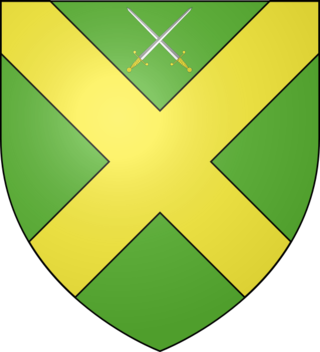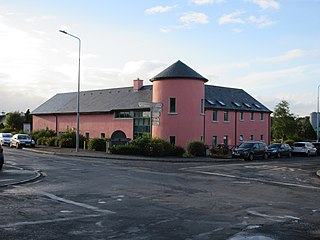
County Sligo is a county in Ireland. It is in the Northern and Western Region and is part of the province of Connacht. Sligo is the administrative capital and largest town in the county. Sligo County Council is the local authority for the county. The population of the county was 70,198 at the 2022 census. It is noted for Benbulben Mountain, one of Ireland's most distinctive natural landmarks.
The Chief of the Name, or in older English usage Captain of his Nation, is the recognised head of a family or clan. The term has sometimes been used as a title in Ireland and Scotland.
Hugh Hyacinth O'Rorke MacDermot, Prince of Coolavin PC, JP, DL, QC, was an Irish lawyer.
Magh Luirg or Magh Luirg an Dagda, Anglicised as Moylurg, was the name of a medieval Irish kingdom located in modern-day County Roscommon, Ireland. It was a sub-kingdom of the kingdom of Connacht from c.956–1585. The kings of Moylurg were a branch of the Síl Muiredaig, who were themselves of the Uí Briúin Ai who descended from the Connachta.

O'Dowd is an Irish Gaelic clan based most prominently in what is today County Mayo and County Sligo. The clan name originated in the 9th century as a derivative of its founder Dubda mac Connmhach. The O'Dowd clan can be traced to the Doonfeeney area of what is now the parish of Ballycastle in Co. Mayo. A large earthen ring fortificatiation still exists called 'Rath O'Dubhda". The nearby early ecclesiastical site at Doonfeeney was more than likely developed under the patronage of the O'Dowds. They descend in the paternal line from the Connachta's Uí Fiachrach. The immediate progenitors of the O'Dowd were Kings of Connacht during the 7th and 8th centuries in the form of Dúnchad Muirisci, Indrechtach mac Dúnchado, Ailill Medraige mac Indrechtaig and Donn Cothaid mac Cathail, before losing ground to their rivals the Uí Briúin.

Cliffoney, officially Cliffony, is a village in north County Sligo, Ireland. It lies on the N15 national route at its junction with the R279. It is only three kilometres away from Mullaghmore which is popular with surfers.

Gurteen or Gorteen is a village in County Sligo, Ireland. It is in the civil parish of Kilfree in the baronry of Coolavin.
Kilglass or Kilglas is a rural townland in County Sligo, Ireland, in the hinterland of Enniscrone.
Monasteraden is a village in County Sligo, Ireland. The village is located on the shores of Lough Gara. St Aiden's church is the village's church. Other sites include Lough Gara Lodge, Slí na Croí's Roundhouse Ecolodge, Drury's pub and the general store.

Prince of Coolavin was a title first applied by popular usage to Charles MacDermot, 1707–1758, then head of the MacDermot family of Moylurg. Coolavin is a barony in south County Sligo in Ireland. Up to the late 16th century the head of the family were still Kings of Moylurg, but had lost their lands due to confiscation.
Sir Dermot MacDermot (1906–1989), styled Prince of Coolavin, Chief of the Name, head of the MacDermot clan, and a descendant of the Kings of Moylurg.
South Sligo was a parliamentary constituency in Ireland, which returned one Member of Parliament (MP) to the House of Commons of the Parliament of the United Kingdom, elected on a system of first-past-the-post, from 1885 to 1922.

Mac Siúrtáin, aka Mac Jordan and Jordan, is the name of a Connacht family of Norman-Irish origins.
Fearghal Ó Gadhra, sometimes referred to as Farrell O'Gara, was lord of Coolavin, and patron of the Annals of the Four Masters.
Ruaidrí Ó Gadhra was an Irish king of Sliabh Lugha and Chief of the Name.
Ruaidri Ó Gadhra was an Irish Lord.
The Ó Gadhra Chiefs of the Name were the heads of the Clan O'Gara, who were originally located in Sliabh Lugha, the southern part of the territory ruled by the Kings of Luighne Connacht. In the 13th century they were expelled from the area and moved to Cul Ui Fionn, later known as the barony of Coolavin, County Sligo.
Ó Gadhra or O'Gara is an Irish surname which originated in the kingdom of Luighne Connacht. Variants include Garry, Geary, Gerry, and Guiry.
The Uí Fiachrach were a royal dynasty who originated in, and whose descendants later ruled, the coicead or fifth of Connacht at different times from the mid-first millennium onwards. They claimed descent from Fiachrae, an older half-brother of Niall Noigiallach or Niall of the Nine Hostages. Fiachrae and his two full brothers, Brion and Ailill, were the collective ancestors of the Connachta dynasty that eventually became the new name of the province. Their mother was Mongfind.








